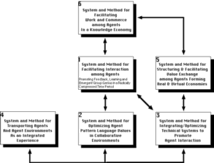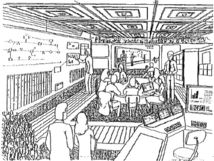c o n f i d e n t i a l
Privileged access only
This is a Hypertext version of the Patent Pending
by iterations of the Taylor System and Method
SYSTEM AND METHOD FOR AUGMENTING KNOWLEDGE COMMERCE
Subsystem 2 Summary
System and Method for Optimizing Agent Pattern Language Values in Collaborative Environments
Overview of the Patent Application
The system and method for optimizing a collaborative work space both in terms of human, (i.e., pragmatic and economic) values and architectural pattern language values provides optimum collaborative work spaces that offer high density, total media integration, greater individual control, larger work spaces, adjustability, reconfigurability and improved pattern language values. The system also includes to a system for design and facility management of such collaborative work spaces and for furniture components for use therein. The system and method for optimizing a collaborative work space is used in connection with the system and method for facilitating communication and other interaction among agents (humans, machines, groups, organizations and combinations thereof) so as to provide feedback, learning and self-adjustment among the individual agents thereby creating an environment for interaction (consisting of environment, tools and processes) that facilitates emergent group genius in a radically compressed time period. The present invention provides a system and components for the system to make it possible to optimize the design of a collaborative work space both in terms of human, pragmatic and economic values as well as pattern language values. In part, the present invention results from the present inventors recognition that systems constructed using linear arrangements of rectangularly-based components are a source of the problem. The variety of objectives that one would ideally like to achieve in a collaborative work space cannot be achieved through the use of known components. An array of new components is required. Thus, the present invention provides a series of components and a system for using these components in combination to achieve results that have not heretofore been obtainable. In contrast to conventional collaborative environments that do not address the entire range of basic human requirements (they require compromise and tradeoff), there is no need to compromise with the system of the present invention. The present invention provides collaborative work spaces, high density, greater individual control, larger work spaces, adjustability and reconfigurability, addresses pattern language values and provides computer-augmented design and facility management. The present invention also provides a system for facilitating design and management of collaborative work spaces. The system is based on the recognition that a collaborative work environment is a collection of objects and that the system has rules. Thus, the system of the present invention knows the cost of certain objects, knows the architectural rules, knows the architectural values and knows the rules of pattern language. This is achieved through the use of values stored in memory tables or the like. Moreover, the system can adjust the relative values of things such as architectural values based on a customers or clients objectives. The system includes means, preferably electronic display monitors, for displaying environmental layout and means, such as icons, for graphically representing objects within the environment. The user can "pick up" and place the objects in desired locations within the environment. The system knows the cost of the objects selected, the architectural rules concerning its placement, the architectural values associated with particular objects in the rules of pattern language. In addition, the system can provide the total cost as well as architectural values score or in the pattern language score, on a real time basis. In accordance with a further embodiment of the invention, the system of the present invention can be used to manage the environment. In particular, the system can be designed so that the individual system knows what objects are in the environment and where those objects are (how the environment is configured). This can be achieved in a variety of ways such as by placing chips in each of the objects or placing sensors within the environment. In this way, the system can monitor an environment once in place and send a warning, if, for example, an object is moved into a place that is architecturally unacceptable (e.g., an object is moved to place where it blocks the door). Thus, in summary, the system facilitates both design and placement of furniture in office, home and other environments and also monitors the environment once in place. This is done through a system, which can be a central computer and/or plurality of individual objects networked, so long as the system knows what the objects are and what they can do, the rules applicable to the environment and the objects and where the objects are and how they are configured. Thus, the system knows its environment, knows what objects are in its environment and what the rules applicable to that environment are. The present invention also relates to various furniture components that make it possible to optimize human and architectural pattern language values in a collaborative work environment. In general, a collaborative work environment may be thought of as including various levels of components. In connection with the component described in this application, the components may be grouped in the following levels (from lowest to highest): I. SUB-COMPONENTS: including, for example, secretaries, file cabinets, pigeon holes and shelves II. PIECES: including, for example, dogs (work units), wings, tables, kiosks III. SYSTEMS including, for example, CubeOffice , WorkPod, Octopus (inside air moving units / lighting) IV. WORK WALLS including, for example, fixed walls, rolling walls, sliding walls, folding walls, and dbl. hung walls. V. ARMATURE including, for example, beams, trellises, chases, path edges and bases. At the highest levels (aside from cities and regions themselves), the environment also includes buildings and the rooms within the buildings. The present invention, however, relates primarily to components below these as listed above. These components are described in the figures attached hereto and in the appendices hereto. One of the principal advantages of the system of the present invention is that the components are provided (as shown in the drawings and appendices) that allow optimization of Pattern Language values. Although certain pattern language values have been used extensively in custom designs by architects such as Wright, there has to date been no way to address most of the pattern language values catalogued by Alexander in practical way with conventional off the shelf furniture, much less furniture that also addresses human values such as economic efficiency, mobility adjustability and the like. Thus, a remarkable aspect of the system of the present invention is that components allow one to address at least 100 of the 253 pattern language values catalogued by Alexander. Further information concerning these pattern language values may be gleaned from "A Pattern Language" Christopher Alexander 1977. Another important aspect of a collaborative environment is access to information. At one level this need can be addressed by providing various printed materials throughout the work space. The furniture components of the present invention are well-suited for this purpose in that they include a variety of shelf space, work surfaces and display surfaces. The work space should, however, also include access to electronic databases including the Internet and data warehouses. To facilitate such access, the environments of the present invention preferably include display monitors throughout the space and furniture components are designed to movably support such monitors. In addition, the furniture components and armature elements are designed to conceal or guide cables and wires connected to electronic components. This collection of components and their arrangement within the environments (as shown in the drawings and appendices) are able to provide total seamless media integration within the environment. In addition, the system is highly scaleable and adaptable to new technologies that are now widely available or likely to become widely available in the next few years, including large scale electronic work walls, electronic assistants, electronic displays, real time video conferencing, intelligent agents and data warehouses. Collectively, these components provide an environment in which information can be made available as needed, i.e., "just in time information," and remote collaboration is seamless. Thus, the system and method of the present invention provide an ideal environment for the integration of "query tone" technology in which information flows freely as needed in a frictionless market so that decision makers can obtain all the information they need when needed from data warehouses. Specifically, the environment includes a complete range of fully integrated media sources and displays so that, for example, a knowledge worker can turn on a computer (workstation, network computer, lap top, PDA or intelligent assistant), and ask any question from any database anywhere, in the same way that a knowledge worker today can pick up a telephone, and talk to anybody anywhere.. The present invention provides the overall process and environment to take full advantage of "just in time information" and integrate this information into the collaborative work space. Of course, the present invention also contemplates a software agent transportation system that would improve the ability to extract relevant data from databases. Thus, the present invention provides several functional advantages over known systems. To begin with, the present invention makes it possible to design practical layouts of components that cannot be provided using a known systems based on rectangular components. The system of the present invention is useful in facilitating the interaction among agents, i.e., creating an environment for facilitating the interaction among agents including humans and machines. Moreover, the present invention makes it possible, for the first time to address pattern language values using standard components. In the past, known standardized systems have not been particularly useful in addressing pattern language values.
Access to this site is restricted to the following groups:
MG Taylor Corporation Core Staff
MG Taylor Corporation Board and Advisors
MG Taylor Corporation Legal Team
AI Core Staff
KnOwhere Stores Core Staff
Yolke Core team
iterations
CAMELOT KreW
BDO Evaluation Team
MGT Core ValueWeb Team
Alacrity Ventures
HP Star Team
If you are not a member of these groups and received your passwork from Matt Taylor or your team leader, you are violating the privacy of iterations and MG Taylor
- unauthorized access WILL BE PROSECUTED -
Contact:
Matt Taylor 843 671 4755
posted June 1, 2000
revised June 1, 2000
• 20000601.100349.mt •
(note: this document is about 5% finished)
Copyright© 1982, 1997, 1998, 1999, 2000 Matt Taylor

